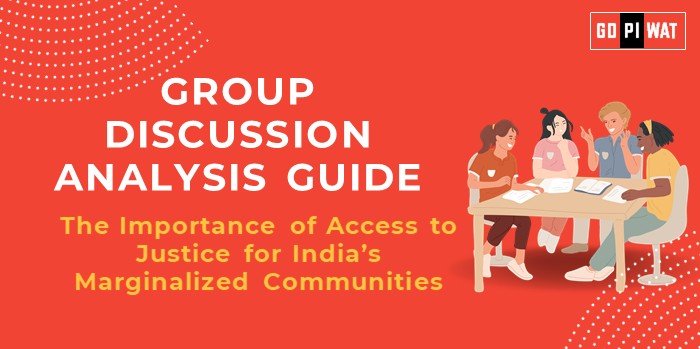📋 Group Discussion (GD) Analysis Guide: The Importance of Access to Justice for India’s Marginalized Communities
🌐 Introduction to the Topic
- 💬 Opening Context: Access to justice is a fundamental human right and a cornerstone of democracy. However, in India, marginalized communities, including Scheduled Castes, Scheduled Tribes, and economically disadvantaged groups, often struggle to access legal mechanisms effectively. The topic emphasizes social equity and legal empowerment in a rapidly evolving democracy.
- 📜 Topic Background: Historically, India’s marginalized communities have faced systemic barriers in accessing justice, from social stigmatization to financial hardships. Landmark initiatives like the Legal Services Authorities Act, 1987, sought to promote free legal aid, yet challenges persist in implementation. Current efforts focus on integrating technology and policy reforms to bridge the gap.
📊 Quick Facts and Key Statistics
- 👥 Marginalized Population: Over 25% of India’s population belongs to Scheduled Castes and Scheduled Tribes, highlighting the scale of inclusion efforts.
- 📚 Access to Legal Aid: 39% of rural households remain unaware of free legal services, per the National Legal Services Authority (NALSA).
- ⚖️ Judicial Pendency: Over 4.5 crore cases are pending in Indian courts (National Judicial Data Grid, 2024), disproportionately affecting the underprivileged.
- 👩⚖️ Gender Justice Gap: Only 14% of judges in higher courts are women, limiting diversity in judicial representation.
🔍 Stakeholders and Their Roles
- 🏛️ Government and Judiciary: Responsible for creating accessible legal frameworks and reducing pendency.
- 🤝 NGOs and Civil Society: Play a critical role in legal awareness campaigns and community support.
- 👥 Marginalized Communities: Key beneficiaries whose empowerment through access to justice can transform societal dynamics.
- 💻 Technology Providers: Offer solutions like online grievance platforms and legal aid apps.
🏆 Achievements and Challenges
Achievements:
- 📜 NALSA Schemes: Over 2 crore beneficiaries have availed free legal aid since 2017.
- 💻 Technology Integration: e-Courts project reduced case processing times by 20% in pilot regions.
- 📢 Regional Success: Kerala’s legal literacy camps helped over 1 lakh women access judicial remedies in 2023.
Challenges:
- ❓ Awareness Deficit: Limited knowledge of rights among marginalized groups.
- ⏳ Judicial Delays: Pendency in rural courts often exceeds 5 years for minor disputes.
- ⚖️ Gender Disparity: Women from marginalized communities face dual barriers of caste and gender bias.
Global Comparisons:
- 🇿🇦 South Africa: Legal Aid South Africa ensures 100% free legal support for cases involving basic rights.
- 🇧🇷 Brazil: Public Defenders’ Offices operate across all states to ensure justice for the poor.
🎯 Structured Arguments for Discussion
- ✅ Supporting Stance: “Access to justice empowers marginalized communities, enabling them to combat systemic inequities and strengthen democracy.”
- ⚖️ Opposing Stance: “Despite efforts, India’s justice system remains inaccessible to the poor due to delays, corruption, and inadequate legal representation.”
- 🤝 Balanced Perspective: “While access to justice has improved through technology and policy reforms, bridging societal and systemic gaps requires sustained effort.”
🗣️ Effective Discussion Approaches
- 📊 Opening Approaches:
- “In a nation with over 25% marginalized population, ensuring justice access is a moral and constitutional imperative.”
- “With 4.5 crore pending cases, the justice system needs reforms to cater to the underserved effectively.”
- 🔄 Counter-Argument Handling:
- Acknowledge delays and recommend fast-track courts for minor disputes.
- Emphasize legal aid schemes’ scalability and the need for digital inclusivity.
🔍 Strategic Analysis of Strengths and Weaknesses
- 💪 Strengths: Legal aid infrastructure, proactive judiciary, digital integration.
- 🔧 Weaknesses: Delays, unawareness, rural-urban justice disparity.
- 🌟 Opportunities: Legal technology, gender diversity in judiciary.
- ⚠️ Threats: Growing distrust in judicial efficiency, rising costs.
💼 Connecting with B-School Applications
Real-World Applications: Focus on inclusive development strategies for projects in public policy and social entrepreneurship.
Sample Interview Questions:
- 💡 “How can technology improve access to justice for rural communities?”
- 💡 “Evaluate India’s legal aid mechanisms against global best practices.”
Insights for B-School Students:
- Study public-private partnerships in legal tech.
- Explore judicial reforms in project reports.


